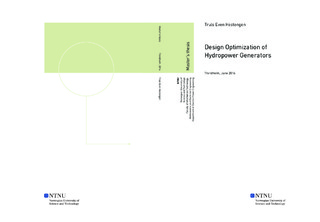| dc.description.abstract | For education and research purposes, a design calculation program for hydropower generators has been made. The user can change design parameters to optimize the generator. However, manual optimization is a slow and tedious process and the user might make mistakes which will lead to wrong results. With an implemented optimization in a computer program, the optimization could be made faster and more reliable. In this assignment, a genetic algorithm is implemented in MATLAB to optimize the synchronous generator with respect to the total cost of the machine, which include cost of materials and losses. The purpose of the optimization was to find the lowest machine cost by varying chosen geometrical parameters. The variables were selected during conversations with supervisor Arne Nysveen and Ph.D. candidate Erlend Engevik.
MATLAB has embedded functions that can perform genetic algorithms when provided with objective function, number of variables and constraints. The design calculation program mentioned has been used actively and made the foundation for the objective function to the implemented optimization. It has been adjusted to meet the demands of objective functions for optimization problems in MATLAB. Furthermore, limits to the machine design has been implemented as nonlinear constraints. These are gathered in a script under the function name \textit{nonlcons}. For every set of variable values, the algorithm call this script to check if the constraints are met.
To test the implemented optimization, the price of load dependent losses was increased to see if this made the algorithm reduce these losses. Furthermore, the power factor was increased which should make the machine cheaper. Lastly, the synchronous reactance was increased. For high values of the synchronous reactance, the air gap drops which lead the total magnetization to reduce, and consequently the total cost of the machine. There were performed 10 optimizations for each case as the genetic algorithm is not likely to give the same result every time. The results were then gathered in Excel and compared to examine how the algorithm had performed.
Results show that the optimization perform as expected. The load dependent losses dropped by 8.1\% when the cost of these increased from 15000 to 20000 kroner per kW. The cost of constant losses were at 30000 kroner per kW for both cases. They did not change considerably. When the power factor was increased from 0.8 to 1.0, the total cost of the machine dropped by 4.4\%. This is because of a reduced magnetization of the machine which reduce the required field current and consequently the copper losses. For the case of a varying synchronous reactance, the magnetization of the machine reduced with 9.3\% as the reactance moved from 1.2pu to 4.9pu. Consequently the total machine cost reduced with 7.6\%.
The results also showed a large variation of the best solution from one optimization to the next. It is believed that a larger population could bring down this variation. However, the genetic algorithm include randomly generated mutation which for complex problems necessarily leads to varying results. Furthermore, the ratio between cost of losses and materials which are set by the user to a great extent affect the machine design. Increasing the cost of losses while keeping the material costs constant causes the use of copper in the machine to increase significantly. The constraints added are important to ensure that the algorithm designs reliable machines that fulfill demands to generators in the Norwegian grid. It is important that the user can adjust these constraint to the problem at hand when they inflict the machine design greatly. | |

